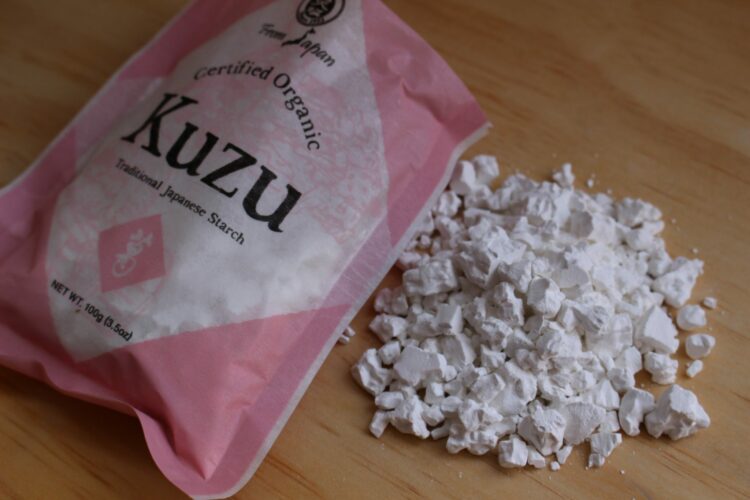Kuzu, this plant-based binder, is very well known in Japan! It is highly valued there for its gelling and smoothing properties that are attributed to traditional sauces such as yakitori sauce, soups and desserts.
What is kuzu?
Kuzu, or kudzu, comes from the Asian climbing plant Pueraria montana. Known for its culinary qualities, it is credited with many nutritional virtues.
It is mainly used as a thickener in the preparation of sauces and soups. While it is widely used in traditional cooking, it is also being studied as a natural remedy to fight addictions.

Origin of kuzu
Because kuzu is a climbing plant, it is also known as the “Japanese vine”. In fact, “kuzu” means “vine”.
For millennia, kuzu leaves in Asia have been used to prepare traditional remedies, notably to counteract the harmful effects of alcohol or to prevent hangovers.
Kuzu root is even considered one of the 50 fundamental medicinal herbs in traditional Chinese medicine. Needless to say, it is also prized for its nutritional benefits.
It is found mainly in India, in China, in Korea and in Japan, growing wild at the edge of forests or along roadsides.
It is an invasive plant that grows very quickly, like ivy, and can therefore easily reach up to 30 metres in height. It grows mainly in warm, semi-tropical climates—not only in Asia. Kuzu was even introduced to Europe during the second half of the 19th century.
What does kuzu taste like?
Kuzu itself has no particular taste. It is often used as a thickening agent in recipes, so its main role is to give dishes a smooth texture and to thicken sauces rather than to enrich their flavours. In short: it works like cornstarch or arrowroot.
When used correctly, kuzu does not alter flavours. Otherwise it will make your dish bitter, so be sure to use it sparingly!
How to use kuzu in cooking?
Kuzu is an ideal natural alternative for thickening soups, sauces and desserts. Always be sure to dilute the kuzu in a little cold water before adding it to your hot preparation.
As a guideline, use about 1 to 2 teaspoons of kuzu for 120 ml of water. Mix until your preparation is smooth and homogeneous, then you can add it to whatever you want to thicken.
Keep the mixture over the heat; the thickening agent is activated only when hot. With this ingredient, you can for example make yakitori sauce—the must-have for chicken skewers!
If you want to play with textures as in Japanese cooking, sprinkle a little over tofu or vegetables before frying them. It will give them a very special crispy effect, reminiscent of potato starch.
How to replace kuzu?
If you can’t find kuzu, there are some very affordable alternatives that we all know. Cornstarch is for example the most common alternative to kuzu. You can use it in the same way; the result will be just as effective.
Another alternative is wheat flour, which works in the same way as cornstarch. The only small drawback is that the texture can end up slightly more granular than usual. Potato or corn starch also works. Be careful not to overdo it so as not to give your preparations a floury taste.
Arrowroot can also be a good substitute. It is an almost similar natural ingredient to kuzu, which also has a thickening effect and can be used exactly like kuzu.
What are the benefits of kuzu?
In Asia, kuzu is often said to have many health benefits. It is believed to relieve digestive disorders, regulate blood sugar and possess antioxidant properties.
Several studies also show that kuzu has interesting effects on addictions, such as alcohol or tobacco.
It has a calming effect and relieves headaches and migraines. However, it is not recommended for young children, pregnant or breastfeeding women, or anyone likely to develop breast cancer.
Where to find kuzu?
Most supermarkets do not offer kuzu, so I recommend going to Asian grocery stores or simply shopping online on specialised websites. You can also buy Kuzu on Amazon
How to store kuzu?
Storing kuzu is very simple: after purchase, transfer it to an airtight container away from heat and humidity. You can then keep it for several months.

